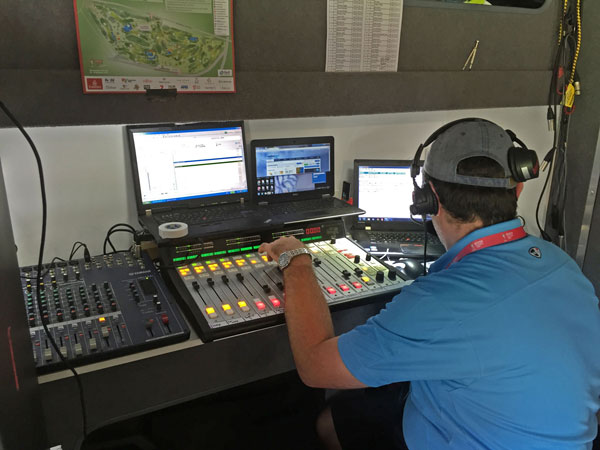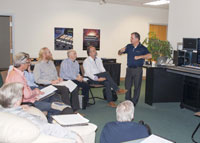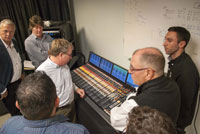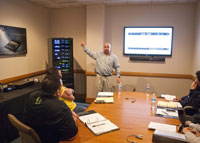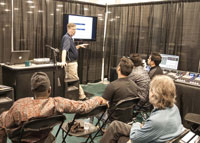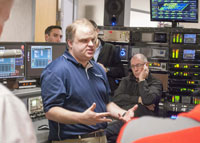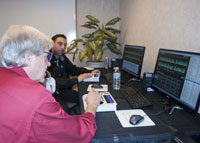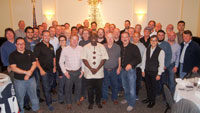WHEAT:NEWS Radio Dec 2015 - Vol 6, No. 11
Got feedback or questions? Click my name below to send us an e-mail. You can also use the links below to follow us on popular social networking sites. The tabs at the very top of the page will take you to our most often visited pages.
Wheat Goes to Washington for AES67 Plugfest
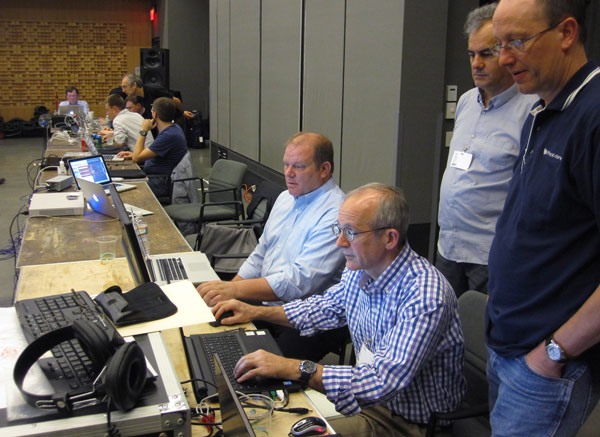
Photo courtesy of AES.
Our engineers Kelly Parker and Dave Breithaupt arrived at NPR’s headquarters in Washington, DC last month with a WheatNet-IP audio network to participate in the second AES67 plugfest. This plugfest was a follow up to the AES67 system compatibility testing conducted in Munich last year, and provided for further testing on multicast as well as unicast streaming.
AES67 requires support for both multicast and unicast streaming, the former of which needs the Session Initiation Protocol (SIP) for connection management. A number of products participating in the plugfest support unicast and SIP, including our WheatNet-IP audio network.
Thirteen products were tested, with AES67 implementations varying from software on a PC to hardware-based FPGA solutions.
According to a preliminary AES report summing up the plugfest, “Although these tests involved a growing number of devices compared to the previous plugfest, a majority of unicast streams interoperated successfully.” However, because SIP interoperability was not achieved in some cases, the report suggests that an SIP technical overview and recommendation be published prior to subsequent AES67 plugfests in order to ensure the best possible conditions for SIP interoperability.
Multicast interoperability was also thoroughly tested during the plugfest, and according to the preliminary report, “most combinations (94%) were successful. Many of the receivers were able to interoperate despite some conformance issues.”
The plugfest took place last month to confirm the interoperability of various products according to the AES67 standard that was first published in 2013 and revised in 2015. AES67 requires interoperability with linear PCM audio coding, a sampling frequency of 48 kHz, 16 or 24 bits-per-sample, 1 to 8 audio channels (2-channel stereo presumed to dominate), and a packet time of 1 ms.
The next plugfest is expected in 2016 in the U.K.
Fiber FAQs

We’ve been getting a fiber vibe lately, and wanted to know if we were picking up on a recent trend in network cable. So we called our good friend Steve Lampen with Belden, the little cable company that purchased Grass Valley and Miranda. Lampen, who comes from a long line of lamp makers hailing back to Old Europe, shed some light on the subject.
WS: We’ve noticed a lot more interest lately in fiber architecture as a way to connect together our WheatNet-IP audio network. Is it just us, or is this something of a recent trend?
SL: You aren’t imagining things. We are clearly at a transition period between the old copper world and the fiber world. Copper can handle enough bandwidth at this point, but the question is how much more do broadcasters want? Eventually there’s a limit and it’s more a distance limit because as the bandwidth goes higher and higher, (copper cable) distance gets shorter and shorter.
WS: Category 8 cable is probably the best example of this, huh?
SL: Yes. Category 8 cable is 40 gigabits. But the problem is, that cable will only go 100 feet/30 meters, not 100 meters like the data cables do now. So there are limitations with CAT8, in which case you might want to go with fiber. Keep in mind, though, that you can certainly do 40 gigs on fiber, but it takes eight fibers to do it. And, of course, you have to have a converter for each pair of those. Not as trivial as you might think.
By the way, we were the first people to put plastic over fiber in 1973. People don’t often think of us as being into fiber, but we definitely are.
WS: Okay, so when should broadcasters consider fiber?
SL: There are actually several reasons to run fiber. If you’re going really long distances, for sure, but also if you want something that’s impervious to lightning or something that’s impervious to RFI and EMI, that’s going to be fiber. These are the reasons why the country is filled with fiber from the build-outs of the ’70s and ‘80s.
WS: On the flip side, why not just go with fiber and be done with it? It has the capacity, the range, the RFI/EMI immunity?
SL: Cost, mainly. Copper has limitations, yes, but you don’t have to convert. You just plug it in. For fiber, you need the converter that converts from electrons to photons on one end of the fiber, and at the other end, from photons to electrons. So it’s going to be more expensive. Even now, with prices dropping, fiber is still expensive. Not the fiber itself, that’s a wash—that’s the same price as a coax. Even the high bandwidth stuff, the single-mode, is getting cheaper than the multi-mode stuff. All that is really coming down in price, but will it ever surpass copper? Well, here’s the interesting thing about fiber. The thing that will make a huge difference in fiber (adoption) is when they can play with photons in the circuitry in the box, when they can amplify signals with photons, when they can split signals with photons, when they can combine signals with photons. This is a whole different deal because then fiber can do all the stuff that you used to do with electrons. This doesn’t exist yet, but they are getting very close.
Until then, most broadcasters will probably implement more of a hybrid architecture.
WS: Hybrid? As in, both fiber and copper cable?
SL: Right. We had a really good example of this when we decided to bring all the cable out on display at IBC this year, instead of hide it in a back engine room. In one rack, it’s all coax. In the next rack, it’s 10 gigabit copper data pairs. And in the third rack, it’s all fiber optic cable. That’s where broadcast is now, a hybrid of each. Will any of these win? Eventually perhaps, but it could also be something entirely different and new. I mean, we haven’t even started talking about new technologies that could change the entire architecture, like carbon nanotubes or room temperature superconductors that if they arrive, could put both copper and fiber in the museum.
WS: That sounds like a discussion we’ll have to save for another day. Thanks, Steve.
IP Audio, Par for Australian Open Course
George Biagioni is IT Director for Crocmedia, an independent syndicator of sports content located in Victoria, Australia.
We recently returned from the 2015 Australian Open Golf Tournament, where my crew and I spent the better part of a week making the rounds and reporting live to spectators there as well as to listeners tuning in to sports radio station, SEN, in Melbourne and SportFM 9.13 in Perth. This marks the second year for Australian Open Radio, a temporary low-power station that Golf Australia contracted my company to set up in order to bring fans closer to the action. This special-event broadcast presented some unique challenges, and therefore required a most interesting mixture of technology to reach the ears at the tournament as well as those listening elsewhere.
Here’s how we made it all work using 4G iPhone 6s with Report-IT, Tieline Genie distribution, a 5W transmitter, and Wheatstone IP audio networking, audio processing and IP console.
A special event license allowed Australian Open Radio to broadcast from the course using a local 5W transmitter. More than five thousand VHF receivers were distributed to spectators by Golf Australia to follow all the golfing action live. The coverage was also picked up online by spectators at home or on mobile devices using apps for iPhones, iPads, and Androids.
Our commentary team of Andrew Maher, Mark Hayes, Mike Clayton, John Huggan, Martin Blake and Matt Cutler used iPhones with Tieline’s Report-IT Enterprise codec application to report live throughout the event. This year, we were able to use new iPhone 6s. The new phone gave us 4G wireless connectivity to the Tieline Genie distribution unit; it also has a battery saving application that gave our reporters up to six hours of use before having to be recharged.
With mobile phones banned on the course, we had the 4G network to ourselves. The alternative would have been to go with wireless mics, but getting frequencies for those would have been far more difficult and these can get costly. We noticed that the host broadcast television crews had significant issues with their radio mics used around the course last year, and I felt relieved to not have to search for clear RF frequencies.
Also making all this possible is the Opus codec algorithm used in the Report-IT app and the Genie distribution unit. It proved to be a very efficient codec. Add to this Tieline’s SmartStream IP technology, and delay was virtually non-existent. Tieline’s automatic jitter software measured prevailing network conditions and adjusted latency accordingly. At times total latency was as low as 80ms.
(Editor’s note: SmartStream Plus used over inexpensive IP links to transport STL-grade, high fidelity audio is a fraction of the cost of synchronous leased lines and satellite links. When multiple redundant audio streams are sent, the decoding codec automatically reconstructs audio into a perfect single stream on a first packet arrived basis to ensure audio integrity. Using SmartStream Plus, the codec can stream simultaneous redundant data streams from both Ethernet ports and deliver seamless redundancy by switching back and forth, without loss of audio, from the nominated primary data link to the backup link if one fails and then subsequently recovers.)
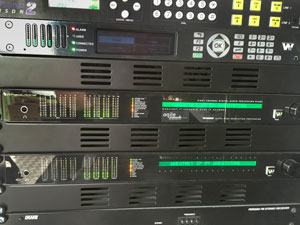 WheatNet-IP Integration
WheatNet-IP Integration
The iPhones with Report-IT fed into the Genie IP codec, which has WheatNet-IP inside for seamless integration into the WheatNet-IP audio network connected to the IP-12 console. We used Wheatstone’s VP-8IP audio processor to catch any peak levels before the audio went out to the 5W transmitter for broadcast to spectators’ receivers. The equipment was provided by Agile Broadcast, Australia. We broadcast on 62MHz – the old analogue TV frequency that has been switched off and is now available through special licensing. For streaming, we simply added our IP address to the Internet service at the Australian Golf Club.
All audio stream routing was configured using Wheatstone’s Navigator software and this was a breeze to configure.
Each announcer was sent an IFB mix minus and Mark Allen, our studio host, would call them in live. The producer could also directly notify each announcer when we were close to crossing to them. At any time, there were up to three people reporting live as they followed each playing group. We even had live bidirectional conversations between two roving announcers from different sections of the course!
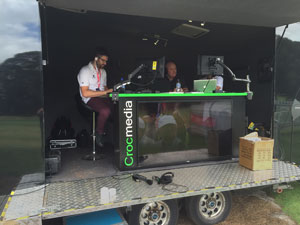 A Cellular Reporting First
A Cellular Reporting First
We are definitely breaking new ground in Australia and perhaps world wide with this new use of technology. I haven’t heard of anyone using a similar configuration using smartphone apps and cellular technology to go live over four days. Feedback was unanimously positive from everyone involved and the connections were very reliable throughout. Spectators and online listeners loved the coverage and from an engineering perspective, we had very positive results.
We will use the same technology at other events in the coming year, and plans are already afoot to grow AO Radio in 2016.

Wheatstone
- Great Eastern Radio (West Lebanon, NH) purchased a Network EDGE IP transport interface unit.
- On Air System of Mexico purchased six E-1 control surfaces and WheatNet-IP audio network BLADEs.
- Agile Broadcast (Victoria, Australia) purchased two E-1 control surfaces.
- Russia Today (Beijing, China) purchased an LX-24 control surface and WheatNet-IP BLADEs.
- C-Span (Washington, DC) purchased four L-8 control surfaces through The Systems Group.
- TBLC Holdings Ltd (Charlotte, NC) purchased an LX-24 control surface and WheatNet-IP audio network BLADE.
- Cox Media (Atlanta, GA) purchased a WheatNet-IP audio network with 44 BLADEs and accessories for the first phase of a WSB-AM studio rebuild.
- Reach Media (Dallas TX) purchased an LX-24 control surface with WheatNet-IP audio network BLADEs for the Tom Joyner show.
- iHeartMedia (Pittsburgh, PA) purchased an L-12 control surface for an additional production room.
- WGN-AM (Chicago, IL) purchased a TS-22 and TS-4 talent station and additional BLADEs for an existing WheatNet-IP audio network.
- Emmis’ KROX-FM (Austin, TX) purchased a TS-22 talent station and four TS-4 talent stations for an existing WheatNet-IP audio network.
- KILR-FM (Estherville, IA) purchased an IP-12 digital audio console.
- Zeera Group (Accra, Ghana) purchased three E-6 control surfaces.
- Zhejiang Radio (Hangzhou, China) purchased three LX-24 control surfaces and WheatNet-IP audio network through Audio Design Company.
- Hangzhou Radio (Hangzhou, China) purchased two LX-24 control surfaces and WheatNet-IP audio network through Audio Design Company.
- New-Press & Gazette’s KRDO-TV (Colorado Springs, CO) purchased an E-6 control surface with WheatNet-IP audio network.
- NFL Network (Los Angeles, CA) purchased a Gibraltar Cage and MADI cards to expand an existing Gibraltar Network.
Audioarts Engineering
- Radio Foshan (Foshan, China) purchased an Air-1 console through Audio Design Company.
- Jade Media (Kuala Lumpur, Malaysia) purchased an Air-4 console.
- Sun TV (Chennai, India) purchased an Audioarts 08 console through Horizon Broadcast.
- KRDR-FM (Red River, NM) purchased an R-55e console.
- KMOM-FM (Roscoe, SD) purchased an Air-1 console.
Wheatstone Audio Processing
- Great Eastern Radio (West Lebanon, NH) purchased an FM-55 audio processor and M1 mic processor.
- Broadcast World Philippines (Manila) purchased an AirAura, VP-8IP and FM-55 audio processor, plus a VoxPro 5 digital audio editor.
- Broadcast Electronics purchased an FM-55 audio processor for a project in Dhaka, Bangladesh.
- Beasley Broadcast (Boca Raton, FL) purchased a VP-8IP multi-mode audio processor.
VoxPro
- KABC-AM/KLOS-FM (Los Angeles, CA) purchased a VoxPro 5 digital audio editor.
- Beasley Broadcast’s WNCT-AM (Greenville, NC) purchased a VoxPro 5 digital audio editor.
- KHKX-FM (Odessa, TX) purchased a VoxPro 5 digital audio editor.
- Entercom (San Diego, CA) purchased eight VoxPro 5 upgrades.
- iHeartMedia (Pittsburgh, PA) purchased two VoxPro 5 digital audio editors for an additional production room.
What's The Deal?
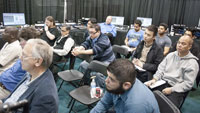
Broadcast equipment dealers from around the world descended on New Bern, North Carolina, last week to attend Wheatstone’s international training seminar. 35 dealers representing sales territories in 46 countries toured the factory where all Wheatstone consoles and products are made, and learned about audio IP networking, audio processing, and new Wheat addition, VoxPro, from the industry pros.
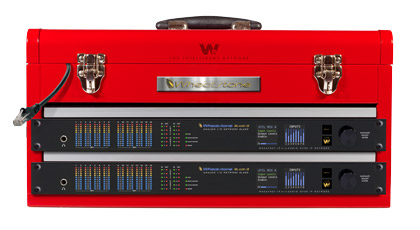
Your Question Answered
 Q: What are the benefits of multiband voice processing?
Q: What are the benefits of multiband voice processing?
A. Multiband processing on voice can help in many different ways. It can help voice cut through in audio challenged media like AM and low bitrate streams. It can also smooth out differences in voice textures between multiple hosts using the same studio/microphone. With news talk formats moving towards higher quality mediums like FM and FM-HD channels, the tailoring of your talent’s audio using multiband mic processing can help increase TSL. Finally, multiband voice processing helps your jock cut through when talking over loud CHR and rock recordings.

